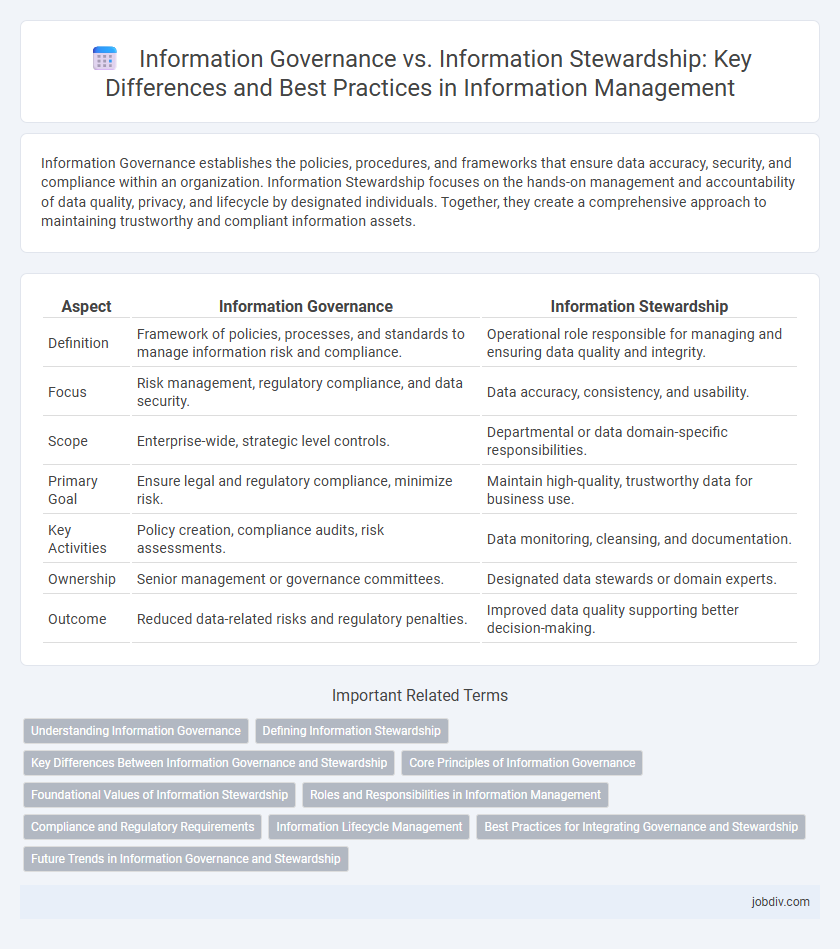Information Governance establishes the policies, procedures, and frameworks that ensure data accuracy, security, and compliance within an organization. Information Stewardship focuses on the hands-on management and accountability of data quality, privacy, and lifecycle by designated individuals. Together, they create a comprehensive approach to maintaining trustworthy and compliant information assets.
Table of Comparison
| Aspect | Information Governance | Information Stewardship |
|---|---|---|
| Definition | Framework of policies, processes, and standards to manage information risk and compliance. | Operational role responsible for managing and ensuring data quality and integrity. |
| Focus | Risk management, regulatory compliance, and data security. | Data accuracy, consistency, and usability. |
| Scope | Enterprise-wide, strategic level controls. | Departmental or data domain-specific responsibilities. |
| Primary Goal | Ensure legal and regulatory compliance, minimize risk. | Maintain high-quality, trustworthy data for business use. |
| Key Activities | Policy creation, compliance audits, risk assessments. | Data monitoring, cleansing, and documentation. |
| Ownership | Senior management or governance committees. | Designated data stewards or domain experts. |
| Outcome | Reduced data-related risks and regulatory penalties. | Improved data quality supporting better decision-making. |
Understanding Information Governance
Information governance encompasses the policies, processes, and controls that ensure data accuracy, privacy, and compliance across an organization. It involves establishing frameworks for data management, risk mitigation, and regulatory adherence to protect sensitive information assets. Strong information governance supports decision-making, legal compliance, and operational efficiency by maintaining data integrity and accountability.
Defining Information Stewardship
Information stewardship refers to the responsibility of managing and overseeing an organization's data assets to ensure accuracy, privacy, and compliance with regulations. It encompasses implementing policies and practices that promote data quality, security, and ethical use throughout the data lifecycle. Effective information stewardship supports organizational goals by enabling reliable decision-making and maintaining stakeholder trust.
Key Differences Between Information Governance and Stewardship
Information governance establishes organizational policies, standards, and frameworks to manage information risk, compliance, and security at a strategic level, while information stewardship focuses on the tactical execution of these policies through data quality, integrity, and accessibility management. Governance defines roles, responsibilities, and accountability structures, ensuring regulatory adherence and data lifecycle management, whereas stewardship enforces data handling, classification, and usage protocols on a day-to-day basis. The key difference lies in governance providing the overarching control environment and strategic direction, with stewardship operationalizing these directives through hands-on data management practices.
Core Principles of Information Governance
Information Governance centers on establishing policies, standards, and controls to ensure data accuracy, privacy, security, and compliance across an entire organization. Core principles include accountability, transparency, integrity, protection, compliance, availability, retention, and disposition of information. Information Stewardship complements governance by focusing on the operational management and responsible handling of data throughout its lifecycle.
Foundational Values of Information Stewardship
Information stewardship centers on accountability, transparency, and ethical management of data, ensuring accuracy, privacy, and compliance with legal standards. Foundational values emphasize responsibility for data quality, protection of sensitive information, and promoting trust through consistent, principled handling of organizational information assets. These core principles differentiate stewardship from broader governance by embedding ethical care and individualized stewardship throughout data lifecycle management.
Roles and Responsibilities in Information Management
Information Governance establishes the overarching policies, standards, and accountability frameworks necessary for managing data assets across an organization, focusing on compliance, risk management, and strategic alignment. Information Stewardship involves the operational responsibilities of managing data quality, security, accessibility, and lifecycle on a tactical level, ensuring data integrity and usability for business processes. The roles in Information Governance often include executives and data governance committees, while Information Stewardship is typically assigned to data stewards, custodians, and business users who handle day-to-day information management tasks.
Compliance and Regulatory Requirements
Information governance establishes the overarching policies and frameworks to ensure organizations comply with legal and regulatory requirements such as GDPR, HIPAA, and SOX. Information stewardship focuses on the operational management and protection of data, ensuring adherence to these compliance mandates through accurate recordkeeping, data quality, and secure access controls. Effective alignment between governance and stewardship mitigates risks, supports audits, and maintains regulatory accountability.
Information Lifecycle Management
Information Governance establishes the policies and frameworks that control data access, security, and compliance throughout the information lifecycle. Information Stewardship involves the operational responsibility of managing data quality, integrity, and usage within those governance policies. Effective Information Lifecycle Management depends on strong governance to define standards and stewardship to ensure consistent implementation and ongoing data stewardship.
Best Practices for Integrating Governance and Stewardship
Effective integration of information governance and information stewardship involves establishing clear roles and responsibilities, ensuring data quality, security, and compliance are maintained throughout the data lifecycle. Implementing standardized policies and leveraging automated tools help enforce consistent practices, while regular training cultivates accountability among data stewards and governance teams. Continuous monitoring and collaboration across departments enhance data accuracy, accessibility, and regulatory adherence, driving better organizational decision-making.
Future Trends in Information Governance and Stewardship
Future trends in Information Governance emphasize the integration of artificial intelligence and machine learning to automate data classification and compliance monitoring, enhancing security and efficiency. Information Stewardship is evolving towards collaborative models that empower data owners with advanced tools for real-time data quality management and ethical usage oversight. Both disciplines increasingly prioritize regulatory adaptability, with frameworks designed to accommodate dynamic legal landscapes such as GDPR and CCPA updates.
Information Governance vs Information Stewardship Infographic

 jobdiv.com
jobdiv.com